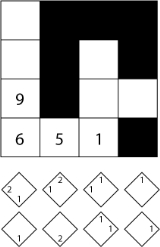
Navigrid
Encyclopedia
Navigrid is a logic
-based number-placement puzzle
. The puzzler is provided with a set of movements which must be used to move between the numbers 1 to 9 in order starting with the number 1. A solved grid will contain each of the numbers 1 to 9. The puzzle setter provides a partially completed grid.
The puzzle was invented by an English puzzle enthusiast, Laurence May, in 2006 and was first published by BBC MindGames Magazine
where it appeared in all 9 issues. It is produced by Vexus Puzzle Design and is currently represented by Puzzler Media. The puzzle appears along with Sudoku
and Kakuro in their "Kakuro" magazine.
Logic
In philosophy, Logic is the formal systematic study of the principles of valid inference and correct reasoning. Logic is used in most intellectual activities, but is studied primarily in the disciplines of philosophy, mathematics, semantics, and computer science...
-based number-placement puzzle
Puzzle
A puzzle is a problem or enigma that tests the ingenuity of the solver. In a basic puzzle, one is intended to put together pieces in a logical way in order to come up with the desired solution...
. The puzzler is provided with a set of movements which must be used to move between the numbers 1 to 9 in order starting with the number 1. A solved grid will contain each of the numbers 1 to 9. The puzzle setter provides a partially completed grid.
The puzzle was invented by an English puzzle enthusiast, Laurence May, in 2006 and was first published by BBC MindGames Magazine
BBC MindGames Magazine
BBC MindGames was a British magazine devoted to puzzles, brainteasers and articles concerning the mind. It was published every four weeks. Its name was taken from the BBC Four show, Mind Games....
where it appeared in all 9 issues. It is produced by Vexus Puzzle Design and is currently represented by Puzzler Media. The puzzle appears along with Sudoku
Sudoku
is a logic-based, combinatorial number-placement puzzle. The objective is to fill a 9×9 grid with digits so that each column, each row, and each of the nine 3×3 sub-grids that compose the grid contains all of the digits from 1 to 9...
and Kakuro in their "Kakuro" magazine.
Rules
When the grid is completed, it must be possible to use every one of the 8 movements to journey from the number 1 to the number 2, the number 2 to the number 3 and so on until you can move from the number 8 to the number 9. A movement must not take you through a black square.Movements
Both parts of a movement must be used but they can be used in either order. Example movements are shown in the first image above. The first movement represents a move of either two squares to the left and then one square down or one square down and then two squares to the left.See also
- Logic puzzleLogic puzzleA logic puzzle is a puzzle deriving from the mathematics field of deduction.-History:The logic puzzle was first produced by Charles Lutwidge Dodgson, who is better known under his pen name Lewis Carroll, the author of Alice's Adventures in Wonderland...
- SudokuSudokuis a logic-based, combinatorial number-placement puzzle. The objective is to fill a 9×9 grid with digits so that each column, each row, and each of the nine 3×3 sub-grids that compose the grid contains all of the digits from 1 to 9...
- Kakuro
- Nonogram (aka Paint by numbers, O'ekaki)
- FutoshikiFutoshikior Unequal is a logic puzzle game from Japan. Its name means "inequality". It is also spelled hutosiki .The puzzle is played on a square grid, such as 5 x 5. The objective is to place the numbers 1 to 5 such that each row, and column contains each of the digits 1 to 5. Some digits may be given...
- KenKenKenKenKenKen or KenDoku is a style of arithmetic and logic puzzle invented in 2004 by the Japanese math teacher Tetsuya Miyamoto, an innovator who says he practices "the art of teaching without teaching". He intends the puzzles as an instruction-free method of training the brain...
- Isolate (puzzle)Isolate (puzzle)Isolate is a logic-based line-placement puzzle. The puzzler is provided with a grid containing walls, dots and a set of area sizes. A solved grid will contain areas of the given sizes containing two dots each....

